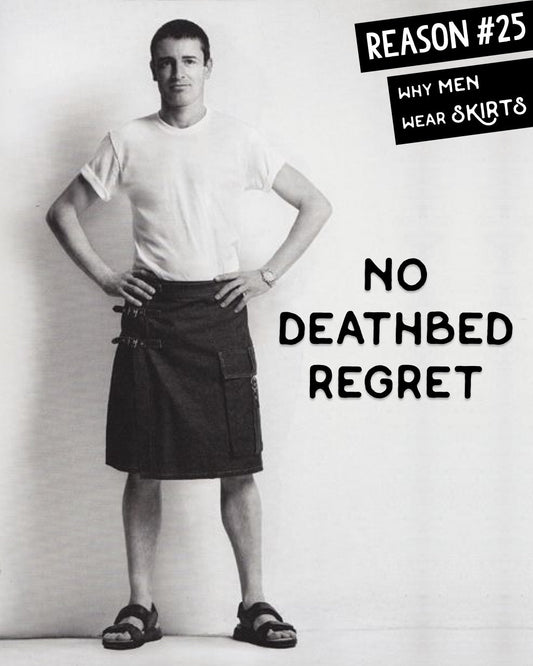
Can Christian Men Wear Skirts?
Chip Palmer
Share
Image above from Slices of Light: 'The Resurrection of Our Lord' (Copyright license; Some rights reserved; Minor image light adjustments made)
———
Although most people aren't Christian, one of the Bible's verses has had a huge impact on culture. A tiny fraction of western men wear skirts today. Until the mid twentieth century, most women didn't wear pants. These acts were illegal or banned in many western spaces, and states in the Bible Belt are trying to create crossdressing bans which could be taken in various ways by police.
Much of the tension comes from a single verse in the Bible. If you're Christian, you've likely come across Deuteronomy 22:5 in the new international version:
"A woman must not wear men's clothing, nor a man wear women's clothing, for the LORD your God detests anyone who does this"
The verse comes from the most popular version of the Bible today, and has been used (decreasingly) for decades to stop women from wearing pants. But what defines womens vs mens clothing?
"There is no Bible passage that defines the characteristics of masculine and feminine garments, though it goes without saying that at the time of Deuteronomy’s promulgation, women and men wore the same type of clothing, but not necessarily the same style of clothing. So while their clothing shared the same structural characteristics, it probably differed in decoration, coloration, trim, accessories, etc." – Vox clamantis in deserto
Digging a little deeper, we can see that 22:5 was altered in 1978. Prior to this, women's clothing in general wasn't mentioned; the text could mean a garment that literally belongs to a woman:
"The woman shall not wear that which pertaineth unto a man, neither shall a man put on a woman's garment: for all that do so are abomination unto the LORD thy GOD"
How did this phrasing come about? In 1611 King James and his translators published this in what became the most popular version of the Bible until recent years. While the translation effort was monumental, they took some drastic liberties in their word choices.
This is a more direct-to-English translation of the Bible verse they attempted to translate:
"The woman shall not put on the weapons (armor) of a warrior, neither shall a warrior put on a woman's garment: for all that do so are abomination unto the LORD thy God"
Though not all scholars will agree, many believe this was trying to say that women shouldn't go to war, and men shouldn't evade war by disguising themselves as women.
Could rigid male dress norms, influenced by Christianity, really originate from a few powerful men with an agenda? This is hardly unexpected.
How Christian males can wear skirts
Depending on their take, a Christian man considering skirts has options:
- Go with an earlier version of 22:5, before any generalizations or mistranslations, as I mentioned above. If you aren't either evading war, or borrowing an actual woman's garment, go for it.
- Define 'womens clothing' in your own way. Men's skirts used to be common in western society, and are standard in several cultures today. The garment's shape isn't cut any better for females than males – actually, we might have it backwards.
- Choose to be part of fashion's evolution. Men are wearing skirts more and more, as women did with pants in the 20th century. They also wear pink which was uncommon 30 years ago. Why should Christians have to be late adopters, waiting for societal norms to change first?
- Ask the big question, WWJD. Although we know Jesus wore a robe/dress and was not a Christian, what would he say about men in skirts today? I tried to approximate this based on all public knowledge about him. Short answer: he wasn't concerned.
- Wear skirts designed for men. These range from the ultra-masculine utility kilt, to many other brands that market specifically to men.
- If anyone asks, say you read the tag upside down, and thought the W was an M.
- If you presume 22:5 was about keeping two sexes distinct:
- Lean into your masculinity. Keep a beard. Wear rugged boots and generally perform "masculine" acts, like chopping wood.
- Don't change yourself. Kindly ask the women and girls around you to wear pants on the days you don skirts. Or convince all women to give up skirts—quickly, before the novelty of pants wears off for them.
- Prioritize another verse, like...
- Galatians 3:28 "...there is neither male nor female: for all of you are one in Christ Jesus."
- 1 Samuel 16:7 (NIV):
"The Lord does not look at the things people look at. People look at the outward appearance, but the Lord looks at the heart." - Deuteronomy 22:12:
"You shall make yourself tassels on the four corners of the garment with which you cover yourself."
- Choose to not live by certain Bible verses, as all Christians do. Or deprioritize the Old Testament, which 22:5 comes from.
- Find an open-minded church.
If I missed anything, let me know in the comments.
———
Biblical scholars have several theories on why 22:5 exists. On top of keeping men from evading war, these range from preventing women from entering the temple, to setting apart Hebrew people from Canaanite and Syrian religion, to homophobia.
One viewpoint calls out integrity as an underlying principle – as in being whole or undivided. Saying that we should be able to easily recognize who is a woman and who is a man, from a distance. Or, 'don't be something that you are not.'
In an attempt to keep genders distinct, a mono-crop of men's fashion arose. Men generally don't stray from a handful of key looks—for example, the suit. Much of which has been massively influenced by interpretations of translations of a few lines of text.
With so many conflicting verses in the Bible, any direction taken from it is a negotiation. Anyone, including me, holds their own bias when deciphering its verses.
The interpretation 'Don't be something that you are not' in a fashion context could look like 'Wear what you love'. And with this, billions of men could have the same number of beautifully different styles.
———
Sources:
- ▶️ Why men wear pants and women wear skirts ǀ Fashion history ǀ Justine Leconte
- What Does the Bible Say About Transgender People? | Clothing and gender expression - Deuteronomy 22:5
- Skirts, Pants, and Deuteronomy 22:5
- We asked the ancients: Should men wear skirts?
Share





11 comments
I would be concerned if someone could prove that this God actually exists and that “he” actually said those things. Until then, I’m fine going my happy-skirted way.
It’s all a load of crap. There’s is no such thing as “men’s” or “woman’s” clothes, there is just clothes. Wear what you want and don’t worry about what somebody wrote in a dumb book a thousand years ago, non of it matters in this day and age. I have NEVER seen a depiction of jesus in anything other then a dress. All the catholic clergy wear dresses. I guess just like anything in that dumb book it can be twisted to fit whatever form of hate you want
@Greg Yes, the Bible has so many different verses that people use or avoid depending on their beliefs/politics/preferences/etc.
And you’re right, whether it’s a robe or a dress, 22:5 did not make distinctions about what is a womens garment vs. mens. And if men wore skirts back then, clearly fashion has changed. This kind of change doesn’t seem to be explicitly frowned upon in the Bible – and maybe that’s why it doesn’t mention specific garments. So as far as the Bible is concerned, further changes should be okay, like with women and pants.
@JeffHayes Thanks for reading. Sorry to hear that your mother doesn’t approve. That must be tough, with her age. It’s nice of you to avoid something that you enjoy, for her benefit. Maybe she will come around at some point! Or maybe not. Either way, I’m glad you’re finding ways to be yourself, despite skirts being frowned upon by your church. It’s funny (and sad) that some people automatically assume a piece of fabric worn with a certain cut is a political statement.
As a Christian, I resent the use of selective verses from the Bible to argue an argument and forget the rest of the text.
Here’s the eighth verse: 8 When you build a new house, make a parapet around your roof so that you may not bring the guilt of bloodshed on your house if someone falls from the roof.
So, how many folks have a parapet?
The fifth verse is abused by closed-minded people. Men wore skirts and dresses when this text was written. Ask anyone trying to use the fifth verse as a reason men can’t wear dresses needs only to show them that men wore skirts and dresses then as mens clothing. So in reality, the fifth verse states men should actually be wearing skirts and dresses.
They’ll make a comeback that I’m they wore a robe (and forget that skirts were common then also). To which I reply, do they really think God makes such a semantic distinction? Like do they really think they can fool God and suggest their bathrobe ain’t just a dress??